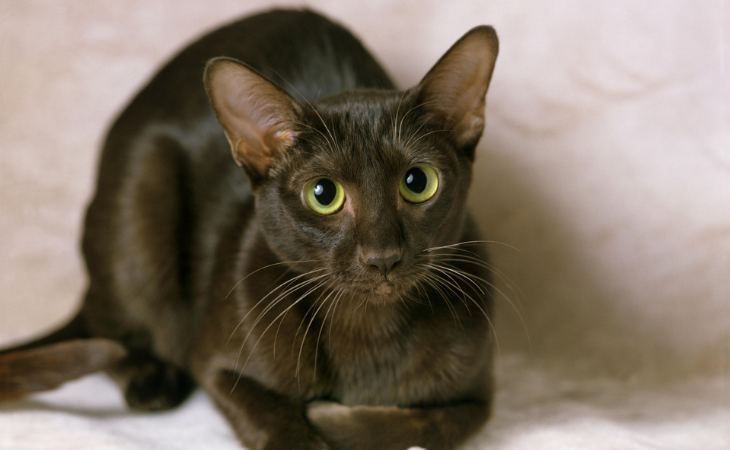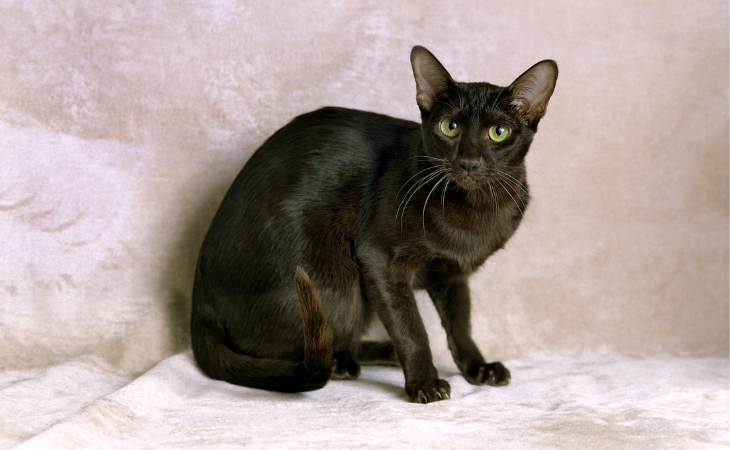Breed standard: CFA, TICA, AACE I Size: Medium I Average Lifespan: 12+ years I Personality: Calm, composed, and affectionate I Coat: Short I Origin: Europe.
Apart from Persian cats and Turkish Angoras who have a plain white coat, few cat breeds have a totally uniform coat like the Havana Brown. In addition, the breed’s brown color is very rare. This is what makes this cat such a special and unique breed!
The origins of the Havana Brown
History of the breed
This cat is the direct cousin of the Siamese cat and appeared in Europe in the 1950’s. This breed is mixed: both American and English. With that being said, this cat originated in England. The breed came to be by mating chocolate Siamese cats with black shorthair cats. This crossing brought forth a relatively rare breed called the Havana Brown.
All around the world
The first all-brown Siamese that came to us from Thailand arrived on the European continent at the end of the 19th century. However, it wasn’t until the mid-20th century that the Havana Brown breed was officially recognized, following the intervention of British breeders. The breed then spread to the United States in the 1960’s and continued to develop throughout the world.
However, it should be noted that this breed is still rather rare, even in its countries of origin. In fact, there are only around a thousand Havana Browns worldwide.
The personality of Havana Brown
If we had to describe the Havana Brown cat in one word, it would be without a doubt: affectionate. Let’s take a closer look at the qualities and downsides of this little four-legged friend.
Qualities
The Havana Brown can get really attached to its owners. It also loves spending time with children. It is therefore the ideal companion if you have children or are looking to expand your family. This breed is also quite calm. With that being said, it really enjoys playing. Most of the time, though, Havana Browns like finding a place on the couch or on you lap to relax on.
As this cat does not really like the outdoors, it can truly enjoy living in an apartment without an outdoor space. Lastly, this cat breed is incredibly intelligent, observative, calm, and composed.
Are there any downsides to having a Havana Brown?
If you adopt this breed, make sure you have time to devote to it beforehand. Although cats are known for their independence, some felines have a great need for attention and affection. This is the case for the Havana Brown breed. This cat follows its owner everywhere and does not like to stay alone for too long. This cat will also not hesitate to meow regularly to show how it’s feeling, especially if it feels abandoned.
The physical characteristics of the Havana Brown
General
The Havana Brown is a medium-sized cat with a rather muscular and athletic build. The males have long legs but the females have the longest legs. This gives them a more slender silhouette than the males.
Head
The head of the Havana Brown is in perfect harmony with the rest of its body. In addition to a flat forehead, the breed has a particularly square muzzle. Males may also have jowls, which are approved for the breed. Lastly, the eyes of this cat are wide open. They are oval shaped and typically green (variations of the color accepted).
Body
There is only one distinction that differentiates the English Havana Brown from its American cousin. It’s its stature. The American Havana Brown are more massive, muscular, and robust. However, this does not mean that the Havana Brown is not elegant. The English Havana Brown, on the other hand, we find more oriental influences at the origin of the breed. These cats have a slimmer silhouette than their American counterparts. With that being said, they are no less muscular. For both variations, the tail is medium and generally fine.

Coat, color, and grooming
Coat
The Havana has a short coat. It is smooth, silky, and shiny. Note that the Havana Brown’s coat can sometimes be denser on the flanks, which is accepted by the breed standard. The coat must be short for a cat to be qualified as a Havana Brown.
Colors
Although predominantly dark, the breed standard accepts all shades of brown. In all cases, the coat color must be uniform, without any patterns. The colors accepted for the breed standard are chocolate and lilac.
Grooming
Unlike other cat breeds, the breed does not require special attention to its health or coat. To keep your little friend healthy and clean, it’s best to brush this breed once a week. During spring and fall shedding seasons, you can brush this cat two or three times. While you are brushing your cat, you can also check their eyes and ears and clean them if necessary. This limits the risk of infection.
Another thing to keep your eyes on is your cat’s claws. Because they not spend much time outside, their claws need to be maintained. It’s best to have a scratching post available for your cat. You can also trim your cat’s nails, contact a grooming salon to do it for you or ask your veterinarian.
Did you know?
As we said before, this breed originated in Great Britain. What is less known is that the origins of the breed can trace back to the 14th century and come from Thailand (then known as the kingdom of Siam). It was then that the first brown cats started appearing. Legend has it that these cats were known for their beauty. Some even said that they brought good luck! The Havana Brown is therefore one of the oldest cat breeds and one of the rarest today.
You might also like reading this article: Top 13 hypoallergenic cat breeds.
The Havana Brown at a glance
Size: 25 to 30 cm (≈ 9.8 to 11.8 in).
Weight: Males usually weigh 3 to 5 kg (≈ 6.6 to 11 lbs) while females weigh around 2.5 to 3.5 kg (≈ 5.5 to 7.7 lbs).
Health: Very robust, few hereditary diseases. Known affections: possible urinary complications and possible respiratory problems in the most fragile.
Average Lifespan: 12 to 18 years.
Is the Havana Brown good with children? The Havana Brown breed is great with children. It is the ideal companion for children because it is gentle, calm, and playful.

